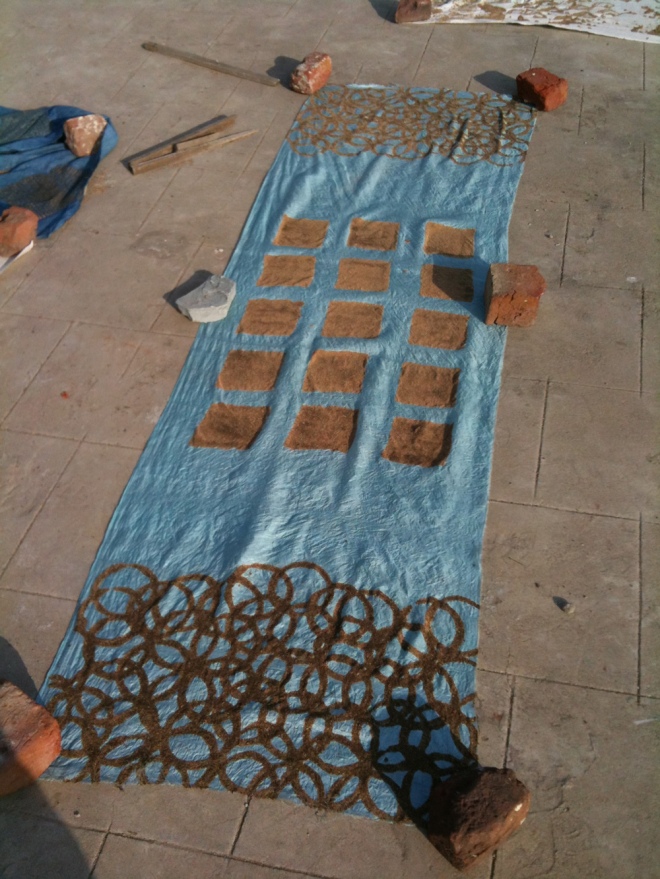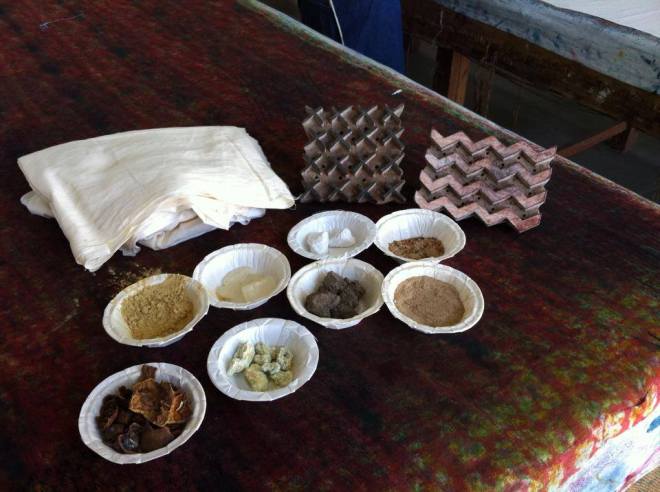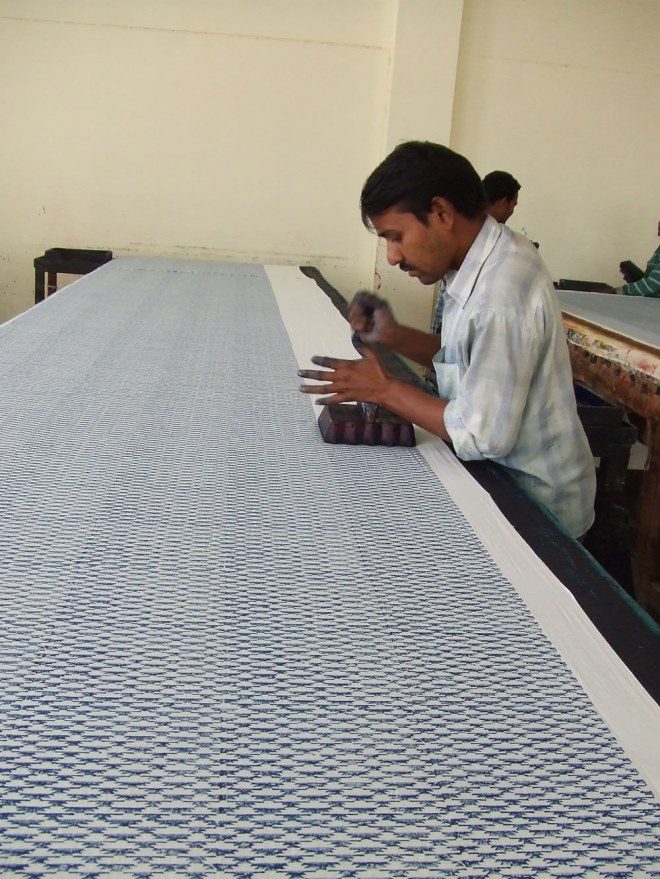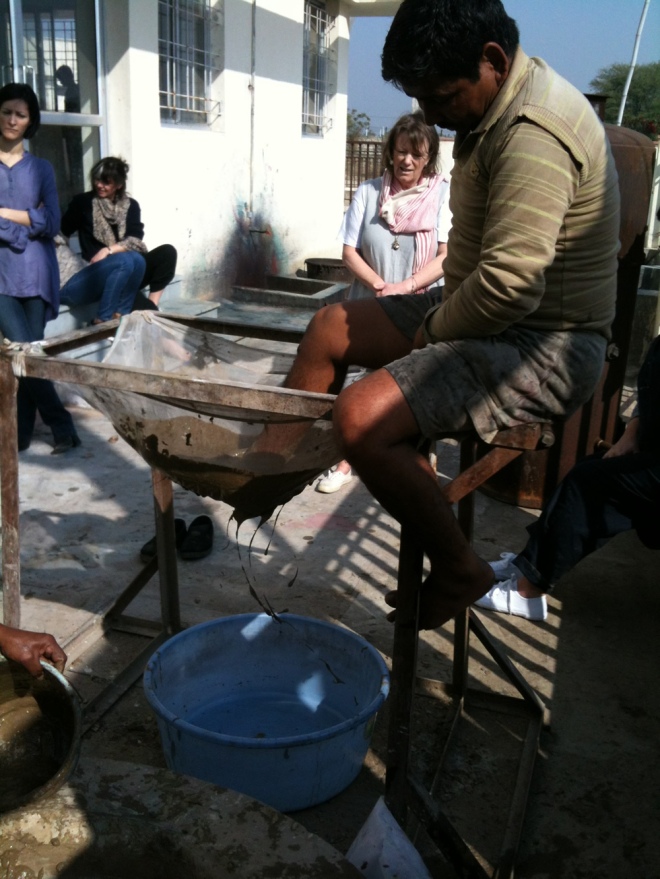[Warning – this is a long post with lots of images!]
Brrr! I’m still adjusting to the drop in temperature since returning to the UK after four weeks in India. 🙂
The last week was spent in Jaipur, on a mud resist block printing and indigo dyeing workshop organised by the Jaipur Virasat Foundation. Along with mud resist, there were also workshops on stitching, miniature painting, mirror mosaics, photography and Indian cookery, so it was an interesting mix.
The tutors for the mud resist workshop were Natalie Gibson, Head of the Fashion Print Course at Central St Martin’s College of Art & Design, and Di Livey, former Senior Lecturer in Textiles & Applied Print at Middlesex University, and visiting lecturer at other institutions. Both were wonderfully colourful characters, both figuratively and literally, with endless supplies of patience and guidance.

The workshop was held about 30km outside Jaipur, near the village of Bagru, at Ojjas, a company that specialises in hand block printed textiles. Company owner Raj Kanwar has 40 years’ experience as a textile designer and was instrumental in the revival of hand block and mud resist printing techniques.
The premises are in a specialist light industrial park, designed to minimise the environmental damage that dyeing can cause. So there’s an effluent treatment plant to recycle water and minimise discharges, and the emphasis is on natural and formaldehyde-free dyes.
Most of the other workers were block printing with pigments on huge long tables – one person would print one colour with one block, then others would fill in the colour with other blocks and colours.
But we were there to print using mud as a resist.
Mud, mud, glorious mud
We started by seeing how the mud (known locally as dabu) was mixed up. Potters’ clay (which they get from dried up lake beds in summer), wheat powder, gum and lime are added to water in a shallow stone bowl, and then the mud mixer mixes it with his feet. It’s quite mesmerising to watch as he swivels and scrapes – like some kind of ritual dance! Once it’s thoroughly mixed, the mud gets sieved through fine muslin – he again uses his feet to push it through.
Then it’s on to the printing. The blocks used for mud printing are different from those used for pigment printing – the carving is deeper and not as fine, as otherwise it would clog up with mud. There was a block printer at Ojjas, carving every block by hand.
After printing, the mud is covered with sawdust to prevent smudging and absorb the moisture. Then the fabric is laid out to dry in the sun (on the roof or on the pavement), weighted down with stones.
Indigo and other dyes
After printing a few samples on the first day, we did our first indigo dips the next day. Ojjas uses synthetic indigo in a fermented vat, sunk into the ground. The vat is 10 feet deep, and had a very impressive “flower” (foam) on the top each morning – a good sign of a healthy vat.
To prevent too much of the mud coming off, the printed fabric was not wetted out before dipping. Instead, it was gently submerged, flat, and moved gently from side to side for about a minute. Then it was removed and held over the vat to allow excess liquid to drip off, and laid on earth for a couple of minutes to soak up the rest. After that it was laid to dry on the roof or pavement as before, until it was dry.
After the first dip we could print again on the fabric before another dip to get two shades of blue. We also had the opportunity to use kassis, a dye made from rusty iron, and pomegranate. Kassis requires a mordant, harda (myrobalan), which is made from a small yellow plum (also used in ayurvedic medicine).
Removing the mud and finishing
Once all the printing and dyeing was finished, the fabric was soaked in warm water for a few hours to soften the mud. Then came the hard work (and fun part), rubbing it and slapping it against a stone slab to remove the mud, before rinsing and drying.
We could also overprint the finished pieces with red, blue, gold or silver pigment, creating highlights and more layers.
The results
After all this work, it was fascinating to see the final results. Most people experimented with clothing, dyeing T-shirts, tunics and trousers, but I stuck to lengths of fabric, including silk, linen and cotton. I also added a bit of stitching to some pieces for extra texture. Here are some of my pieces at various stages.











We had an exhibition on the final day along with all the other workshops, where we certainly exceeded them in terms of quantity of work. 😉 And we even made some bunting!
Bagru
We also visited nearby Bagru, a block printing village where every surface seems to be covered by drying fabric – that is, unless it’s occupied by cows or pigs. 🙂
What I learned
- I’ve never used a fermented indigo vat before, so this was very interesting for me. A single dip resulted in a mid-range blue, but I don’t know how dark the colour would go with successive dips, as we only dipped each piece twice (the mud starts to come off if you dip it more than this).
- Is mud resist a practical method to use at home? You don’t have to use blocks – I used the rim of a terracotta cup, an old piece of circular rubber, and a stone, as well as blocks, to apply the mud to fabrics. A large space helps, but we also saw villagers in Bagru printing on small padded boards while sitting on the floor. Something for the “possibles” list I think!
- I am slightly concerned about the fastness of the indigo with only two dips. The fabric was left for 24 hours between dips and before washing, so it will have oxidised well. But I generally dip a minimum of four times to build up colour and fastness, rinse till the water is nearly clear, wash with a gentle detergent, and rinse again. In Jaipur we soaked to soften the mud and then rinsed – no detergent was used. Given the quantity of fabric we were washing, it would have been a lot of work! But I wonder whether this is the normal practice anyway. I bought some natural-dyed garments from Anokhi, and the information on the label recommended washing before wearing to remove excess dye.
Shop till you drop
One of the advantages of having Di and Natalie to hand was their knowledge of the local shops in Jaipur. Here’s a selection of my favourites.
- New Madho Store, Shop no 138, Bapu Bazaar
Fantastic haberdashery shop spread over three cramped floors – start at the top and work down. A real treasure trove of buttons, beads, trims, and thread. - Khadi Ghar, 320 MI Road
Government-run shop selling hand-spun, hand-woven cotton, silk and other fabrics at fixed prices, providing the weavers with a guaranteed sale of their work. - Saurashtra, 7-9 Inside Jorawar Singh Gate, Amber Road
There’s a whole row of shops next to Jorawar Singh Gate that belongs to the same family. Kishor Kumar Maheshwari and his brothers sell everything from bags and scarves to pashminas and blankets, as well as some antique textiles. - Ojjas, 663 Hanuman Nagar Ext, Viswamitra Marg, Sirsi Rd, Khatipura
This is Raj’s retail outlet, with a great selection of contemporary block-printed clothes, cushions and curtains.

- Nayika, Tholia Building, Opposite Niro’s Restaurant, MI Road
Tucked away in a small courtyard off MI Road, near Khadi Ghar, this boutique sells an exquisite selection of printed and embroidered clothing and homeware. - Anokhi, 2nd Floor KK Square, C-11 Prithviraj Road, C-Scheme
Traditional block printed clothing and popular café serving safe tasty salads and cakes. - Jaipur Modern, 51 Sardar Patel Marg, C Scheme
Sleek Italian-owned boutique selling stylish contemporary clothes and home accessories at Western prices. Also has excellent restaurant.

Finally, here’s a selection of images from other parts of my trip.












































Beyond fabulous and wonderful – thank you so much for sharing your photos. No words – just wonder. Thank you!
Thanks Susan – glad you made it through the epic! 🙂
Reading this while waiting for a bit of paint to dry at work Kim! All sounds wonderful to say the least – your pieces look fantastic and I look forward to hearing how they bear up after washing. The list of shops brought back fond memories of my own time stitching in Jaipur (and shopping) in 2011. Fabulously exotic! X
Thanks Carol – funnily enough I did see some embroidered tape in the New Madho Store that I thought looked familiar from one of your pincushions! 🙂
I’ve washed a linen scarf since coming home, and I had to rinse more than I would usually do with the scarves I dye at home. But the colour of the scarf remains strong. I’m interested to see what happens with the brown scarf dyed with kassis, as I have much less experience with that!
Gosh, it’s a hard life but I guess someone has to do it.
Seriously, fascinating. I’m not an experienced dyer ( I’ve only used an indigo vat once) but love the results. But I love printing and the mud technique sounds fascinating.
And the block printing looks amazing. Ive got a couple of Indian blocks but honestly can never get them to line up!
Fabulous
H xx
I do it so you don’t have to, Hilary! 😉
The block printers were amazing – all lined up by eye, and so quick. Lord knows what they made of our efforts!
Absolutely beautiful results! It looks as though you were bursting with ideas; I always think if I had a great opportunity like this I’d freeze up and not be able to think of all the things I’d love to print!
Thanks Cally. Actually you know how it goes – it takes a few days to learn the process and get to grips with the technique (we didn’t see the final version of our first pieces until day three). So when you see the potential of the technique and get lots of ideas there’s only a couple of days left – not really enough time to try them out. Maybe I’ll have to go again next year! 🙂
I absolutely love this. This would be my dream trip. Anymore coming up? Thanks for such a fabulous post!
Thanks Lisa – glad you enjoyed the post. 🙂
I think they run the workshops every year – Di and Natalie said this was their 11th year of doing it. So keep an eye on the Wonderful Workshops website for next year’s dates!
Your samples look absolutely fantastic, and I can see that you had a wonderful time in India. Looking forward to hearing more about your trip!
Thanks Jessica. Hope the indigo dyeing is going well over there! 🙂
Thanks for your wonderful blog. I wondered where you had been! It was great to see Nathalie….. She taught me when I was a student at Hornsey college of Art in the sixties! I work mostly in felt now but have been Shibori dyeing with Indigo over the last couple of years and use the fabrics in my felt.
Thanks again
best wishes Sue
Thanks Sue – Natalie was great. And she turned heads wherever we went, as you can imagine. 😉 Would love to see some of your work!
It looks like you had a fabulous time. Do you think that any type of mud would work and that you have to add in the wheat powder etc? It’s very interesting to see their processes and I always marvel at their skill. I look forward to seeing the fabric again once washed.
Ruth – I think the mud has to be the right consistency, otherwise it will just fall off in the indigo vat. I could experiment with some from my garden pond, but the frogs probably wouldn’t appreciate me scrabbling around and disturbing them, and I don’t want to ruin my vat. 😉
Di, one of the tutors, did give us some “recipes” for mud, so when my vat is nearing the end of its life I might give it a go!